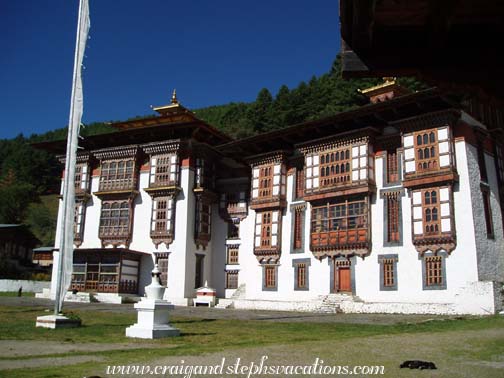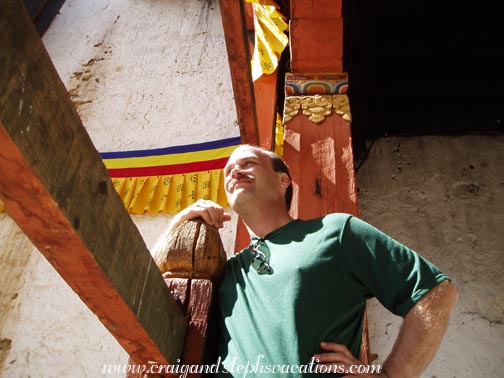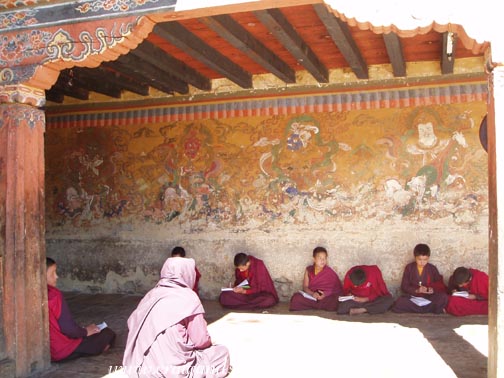We woke up at 5:30 am after a wonderfully refreshing sleep. The cold pills were definitely making a difference and I was starting to feel better. In fact, I had woken Craig up with my snoring during the night, but he was happy that I was at least getting a sound sleep. He took a photo of me in my twin bed, all snuggled up in the covers. After waking up in the morning, we were a bit lazy enjoying the warmth of our respective beds. It was colder here, and we kept the curtains drawn to try to keep some heat from escaping. When we tried to peek out at the grounds, the windows were too foggy to see through.
When we got up, we showered with nice hot water. We got ready for the day and headed over to breakfast. It was a simple breakfast brought to our table: toast, cheese, apple juice, chum thup, and tea, but it really hit the spot. We chatted with some friendly British gentlemen at the next table while we ate.
We then went outside to wait for Dorji. The hotel looked really pretty in the bright morning light. The hotel's friendly resident German shepherd was rolling a large canteloupe-sized rock across the lawn, like a soccer star. She would walk backwards and pull it towards herself with her front paws. She came over now and again to get some petting and then would lay down with her rock and start to chew on it.
Canadian Gail and her husband Narren chatted with us. Yesterday was Indian-born Narren's 60th birthday, and they said that we had left dinner before his cake was served to all of the hotel guests. We explained that we had been on an urgent mission to contact the radio call-in show. They got a kick out of the story. We said that we'd be going to India briefly on our way home, and Narren suggested a truck stop themed restaurant at the Ritz in Delhi, which sounded like a lot of fun.
Dorji and Jigme joined us. Watching Jigme descend the stairs from the guide quarters, it was obvious that he was still in a lot of pain from his boil. We all got into the van and drove to nearby Jampalhakhang, a 7th-century temple dedicated to Jampa, the Future Buddha. We walked through a narrow outdoor corridor where a woman was sweeping the ground. It seemed deserted except for the caretakers and we felt once again like we were intruding on something sacred. The temple contained statues of the Future Buddha (the largest statue), Present Buddha, and Past Buddha behind the altar. The doors were hung with heavy-duty chain mail because in the 14th century the statue of the Future Buddha started floating, and someone made the chains to contain it. Slightly larger-than-life statues of goddesses lined the walls. Silks were faded from time and candle soot. The walls of the building were made of lath and plaster. This was the first temple we had seen where the walls hadn't been covered in canvas. Instead, paintings had been done directly on the plaster, like frescoes. They were detailed and amazingly well-preserved, being protected from light by fabric panels.
Next we drove to to Kurjey Lakhang. The roads were bumpy, and although the distance wasn't far, it seemed to take a long time to get there.
We could see the temple complex from the road, and wondered if we should stop to take a picture. As we drove up the driveway, we realized we were now getting too close to get a photo which accurately conveyed the scale of the place. The perimeter of the complex was lined with small white stupas. As we approached the entrance gate, we passed a boulder which had colorful dzongkha writing carved in relief. The grounds were very pretty, and a woman was sitting on a blanket on the grass, embroidering. The sky was incredibly blue, and we had a gorgeous view of the surrounding green mountains. It was all about Guru Rinpoche here. There were two temples at this site, which were separated by a stairway. The first, lower temple contained an absolutely HUGE statue of Guru Rinpoche draped in silk panels as the focal point. There were very elaborate butter sculptures that depicted the human form. There were also other large statues. The second, upper temple was built into a cave where Guru Rinpoche subdued a demon. You can see his body shape imprinted in the rock. In fact, this is where the temple got its name. "Kur" means body and "Jey" means print. One wall contains 1000 golden statues of Buddha, and the opposite wall had a clay representation of the family tree of the deities. Several women were worshiping inside of this temple.
Dorji had found out from our hotel management that there would be a festival at the Jakar Dzong tomorrow. Today was a dance rehearsal ("without the use of masks"). We drove to the dzong at about 10:00. It sat built into a mountain and overlooking town, looking like the keel of a ship. Dorji led us up a set of stairs, through the gates, and to the courtyard. Dorji told us to meet him at the van at noon, and he went back to meet Jigme. There were a handful of tourists and many locals along the perimeter of the courtyard, watching the dance rehearsals. The percussion and dancing was very familiar, after the Shelmakha festival. Monks were dressed in robes dancing and sometimes beating drums.
The atsaras (clowns) were the only ones in full costumes (complete with masks) and they were carrying their trademark carved phalluses as they cavorted around, interacting with the crowd as well as the dancers.
There was an adorable little girl of around 2 on her mother's back that would go absolutely ballistic every time an atsara came near her. At one point the mother looked at the clown and made the "tssss!" noise usually associated with chasing off dogs. The dances were similar to Shelmakha but they were very lengthy. As the monks danced and twirled around, the full skirts of their burgundy colored robes flared around them. They jumped high and spun like dervishes. After a while, the clanging of the cymbal through the loudspeaker went right through me. It was cool in the shade of the courtyard. I sought out the sun as I had left my fleece in the car. Monks came out with handheld drums and danced with them. One of them had a tear in the drumhead. An atsara came over and asked our names and pretended to write them down. A kid kicked the clown while he was talking to us.
At 11:45 we went to meet Dorji and Jigme at the van and headed back to the hotel for lunch. We chatted with Ann (a member of the UK group) who was seated at the table next to us. She was sitting out her group's afternoon hike due to an ankle injury. Lunch was white rice, fried "boneless"-in-name-only fish, veggies, ginger potatoes, spinach and cheese. I drank Bhutanese apple juice and Craig had tea.
We ate apples for dessert and left in the van at 1:10.
Our first stop was Tam Shing monastery, built in 1501 by Pema Lingpa. It had an outer courtyard with a guest house and a stone marker to indicate land boundaries. We passed through to an inner courtyard where young monks were studying. We entered a door and found ourselves in a stone corridor. On the first floor, the 7th century paintings were really fading, and there were no current plans for restoration. These paintings were once again painted directly onto the wall plaster rather than on canvas. In some spots the painting was no longer visible. In the temple, there were Present, Future, and Past Buddha statues as well as golden statues of the 8 manifestations of Guru Rinpoche. All of the statues were fashioned of clay (at that period in time they didn't use wire frames). There was a heavy duty (25kg) piece of chain mail made by Pema Lingpa here. It is said that carrying it around the monastery three times will cleanse people of all of their sins. Upstairs the ceilings were very low. Pema Lingpa was known for his diminutive stature, and it is said that the ceilings were custom built to suit his height. There was a "conference room" which had a gallery overlooking a screened off chapel which contains a throne for each of the current reincarnations of Pema Lingpa (body, mind, and speech). If one of the reincarnations cannot attend an important ceremony, his photograph is displayed on his throne and this is considered to be a suitable stand-in.
Dorji pointed out an unusual stone which, when you knocked on it, sounded and felt hollow. The upstairs temple contained a statue of the Buddha of Long Life, and there were all kinds of familiar-looking festival hats, masks, drums, etc. on display.
Our last temple of the day was Koen Chosum Lhakang. It was a small temple and its interior was laid out much like that of the Temple of the Divine Madman. An older monk was the caretaker and let us in. A young boy of around 3 years was playing peekaboo from a doorway and singing. There were some statues inside (Buddha and various saints) and some silks. There was a large heavy bell which could supposedly be heard from Tibet. It is said that the Tibetan army broke it. Another piece of it is housed in the National Museum. We probably saw it, but so much had happened between then and now, and my head was so full of so much new and exciting information, that I honestly couldn't remember. Long rows of monastic residences were being constructed in front of the temple. This is the very definition of manual labor. The workers were breaking stones by hand. As we got into the van, they stared at us and I took their picture.
We hit the road again and there was a roadblock. The British group's bus was stopped here, along with several other tourist vehicles. We were stopped as well, and things seemed to be taking a long time. We wondered if there was trouble. But we were just asked to show our papers and we were then on our way once again.
Our final stop for the day was Burning Lake (which is actually a river). Pema Lingpa was approached by an old woman here and he discovered a temple housing treasures hidden by Guru Rinpoche. Nobody believed him, so he said that if he had truly been the one to discover these riches, he would be able to emerge from the river with the treasure and a lit butter lamp. He did so, and from then on the name of the place was called Me-Bar Tso ("Burning Lake") in honor of his deed. There were a lot of prayer flags strung up here - enough to support a center pole upright on top of the rocky ground. We viewed the river from the rocks above. The current was swift and the late afternoon shadows played tricks on our eyes. It looked like the river moving through the gorge was actually slow-moving tar. As we walked back to the van, we passed a niche in a boulder under which were displayed many mini-chortens made of human ashes. The boulder protected them from the elements. It was a very nice little memorial to hundreds of departed souls.
We had been told by many people (mostly Bhutanese) that the Bumthang Valley (of which Jakar was a part) was the most beautiful countryside in all of Bhutan. I honestly didn't share their view, and I think I know why. It reminded me very much of New England. Though it was very pretty, it felt familiar to me. The rocks, gorges, rivers, trees...it looked very similar to New Hampshire. This is a contrast to the rest of Bhutan, which is probably why the Bhutanese find it such a novelty. I, for one, was more impressed with the more "exotic" landscape of Punakha with its terraced valleys and mountainous Shelmakha with its bright yellow fields of mustard plants.
We headed back to the Mountain Lodge by 4:00 so that Jigme could get the van a check-up before tomorrow's long drive. We listened to Kuzoo FM on the radio, and heard an interesting report on kites. Kuzoo has interesting little segments, and this one read like a high school report on the history of kites. It had a thesis statement and then went on to explain the various types of kites, countries of origins, usages, etc. It was very interesting, and we laughed thinking that something like this would never make it on the air at home. We also heard a segment on English grammar, which pointed out the subtle differences between similar words, such as "uninterested" and "disinterested."
When we got back to the hotel, we sat in the sitting area of the dining room and had tea and biscuits with the Brits. They were very friendly and shared some cheese and crackers they had bought at the Swiss shop down the road. It was now that we first met Tony, a charming bloke who reminded us of Michael Palin both in looks and personality. We really hit it off with him and were constantly joking around. My voice was rather raspy and I was coughing, and Tony kindly gave me a couple of his Fisherman's Friend cough drops, for which I am grateful as they worked wonders. The ladies of the group warned me not to go near them as they taste so strong, but they were just what I needed. We headed back to our room to write in the journal. It was chilly up there. There was a wood stove in our room but we didn't want to deal with it, if it even worked at all. So I snuggled under the covers to write.
We headed down to the dining room at 6:30. Peter from the British group joined us in the sitting area, and then the rest of the UK crew. Craig got a Druk 11000
from the bar. As we moved eastward, the beer choices became more and more limited. I had an orange Mirinda. We had dinner, which consisted of a yummy vegetable soup followed by a buffet spread of red rice, cheese momos, beef with cashews, eggplant with cheese, and "potato roastee". It was really good as opposed to last night, which had been so-so. After dinner we chatted with Tony and had tiny bananas with tea. We settled our bill for drinks and went back to the room at 9:30. I wrote in the journal and then we went to bed.
|

Jampalhakhang

Kurjey Lakhang

Kurjey Lakhang

Jakar Dzong

Festival rehearsal at Jakar Dzong

Craig watching festival rehearsal at Jakar Dzong

Festival rehearsal at Jakar Dzong

Young monks studying at Tam Shing

Me-Bar Tso (Burning Lake)

|






